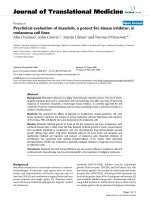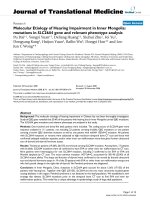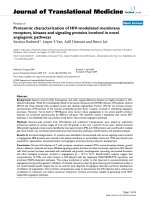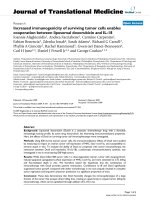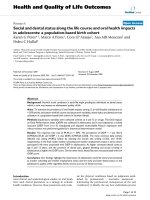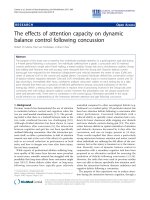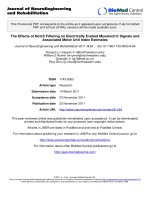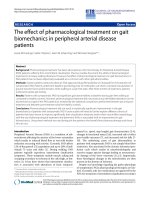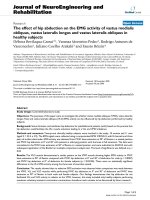báo cáo hóa học:" Increased vulnerability of rural children on antiretroviral therapy attending public health facilities in South Africa: a retrospective cohort study" docx
Bạn đang xem bản rút gọn của tài liệu. Xem và tải ngay bản đầy đủ của tài liệu tại đây (322.5 KB, 10 trang )
RESEARC H Open Access
Increased vulnerability of rural children on
antiretroviral therapy attending public health
facilities in South Africa: a retrospective cohort study
Geoffrey Fatti
1,2*
, Peter Bock
1,3
, Ashraf Grimwood
1
, Brian Eley
4
Abstract
Background: A large proportion of the 340,000 HIV-positive children in South Africa live in rural areas, yet there is
little sub-Saharan data comparing rural paediatric antiretroviral therapy (ART) programme outcomes with urban
facilities. We compared clinical, immunological and virological outcomes betw een children at seven rural and
37 urban facilities across four provinces in South Africa.
Methods: We conducted a retrospective cohort study of routine data of children enrolled on ART between
November 2003 and March 2008 in three settings, namely: urban residence and facility attendance (urban group);
rural residence and facility attendance (rural group); and rural residents attending urban facilities (rural/urban
group). Outcome measures were: death, loss to follow up (LTFU), virological suppression, and changes in CD4
percentage and weight-for-age-z (WAZ) scores. Kaplan-Meier estimates, logrank tests, multivariable Cox regression
and generalized estimating equation models were used to compare outcomes between groups.
Results: In total, 2332 ART-naïve children were included, (1727, 228 and 377 children in the urban, rural and rural/
urban groups, respectively). At presentation, rural group children were older (6.7 vs. 5.6 and 5.8 years), had lower
CD4 cell percentages (10.0% vs. 12.8% and 12.7%), lower WAZ scores (-2.06 vs. -1.46 and -1.41) and higher
proportions with severe underweight (26% vs.15% and 15%) compared with the urban and rural/urban groups,
respectively. Mortality was significantly higher in the rural group and LTFU significantly increased in the rural/urban
group. After 24 months of ART, mortality probabilities were 3.4% (CI: 2.4-4.8%), 7.7% (CI: 4.5-13.0%) and 3.1% (CI:
1.7-5.6%) p = 0.0137; LTFU probabilities were 11.5% (CI: 9.3-14.0%), 8.8% (CI: 4.5-16.9%) and 16.6% (CI: 12.4-22.6%),
p = 0.0028 in the urban, rural and rural/urban groups, respectively. The rural group had an increased adjusted
mortality probability, adjusted hazards ratio 2.41 (CI: 1.25-4.67) and the rural/urban group had an increased adjusted
LTFU probability, aHR 2.85 (CI: 1.41-5.79). The rural/urban group had a decreased adjusted probability of virological
suppression compared with the urban group at any timepoint on treatment, adjusted odds ratio 0.67 (CI: 0.48-0.93).
Conclusions: Rural HIV-positive children are a vulnerable group, exhibiting delayed access to ART and an increased
risk of poor outcomes while on ART. Expansion of rural paediatric ART programmes, with future research exploring
improvements to rural health system effectiveness, is required.
Background
South Africa has the largest paediatric HIV epidemic and
the largest paediatric antiretroviral treatment (ART) pro-
gramme in the world [1]. By mid-2009, an estimated
340,000 children younger than 15 years of age were living
with HIV infection [2], of whom approximately 70,000
were receiving ART [3]. Paediatric ART outcomes
in South Africa have shown favourable short-term
responses [4-7], with a recent cohort study involving
more than 6000 children demonstrating that ≥80%
achieved virological suppression during the first three
year s of treat ment [8]. Despite the rapid scale up of ART
programmes, marke d inequities remain in access to early
infant diagnosis and ART provision between different
areas of the country [9].
* Correspondence:
1
Kheth’Impilo, Green Square, 37 Hares Crescent, Woodstock, 7925, Cape
Town, South Africa
Full list of author information is available at the end of the article
Fatti et al. Journal of the International AIDS Society 2010, 13:46
/>© 2010 Fatti et al; licensee BioMed Central Ltd. This is an Open Access article distributed under the terms of the Creative Commons
Attribution License ( which permits unrestricted use, distribution, and reproduction in
any medium, provided the original work is properly cited.
Limited information on the outcomes of children
managed in rural ART programmes is available in South
Africa. A cohort from a single rural sub-district in the
province of KwaZulu-Nat al demonstrated e ncouraging
short-term ART outcomes [10]. However, a large pro-
portion of children developed virological failure and
major drug-resistant mutations on first-line ART in
another rural cohort [11]. Most paediatric ART studies
in South Africa have included only urban children [4-8],
with no direct comparisons between outcomes in rural
and urban children. More than 40% of South Africa’ s
population, however, lives in rural areas [12,13].
The prevalence of HIV in children and adults is as high
in rural as in urban areas [14], and certain rural districts
have reported extremely high infection rates, particularly
among women [15]. A recent comparison of ART out-
comes between urban and rural children at three Zambian
sites demonstrated rural children having higher levels of
malnutriti on at presentation and having higher mortality
rates while on treatment [16] . Difficulties in providing
rural ART in sub-Saharan Afr ica include a lack of health
personnel, lack of diagnostic facilities, difficulty and
expense transporting medication to clinics, and a lack of
staff training in paediatric ART delivery [10,15,17].
In order to further examine the effectiveness of pro-
viding rural paediatric ART in low-income settings, the
aim of t his study was to compare clinical, immunologi-
cal and virological outcomes between rural and urban
children on ART in a large cohort from multiple public
health facilities in four provinces of South Africa.
Methods
Study design, setting and participants
A retrospective cohort study of children enrolled on ART
was conducted at 44 routine public healthcare facilities
supported by Absolute Return for Kids South Africa
(subsequently named Kheth’Impilo), a non-governmental
organization (NGO) that supports the scale up of ART in
public sector clinics in South Africa. Seven rural and 37
urban sites that had electronic data collection systems
used for patient monitoring purposes were included in
the study. Facilities were distributed across four pro-
vinces (Western Cape, KwaZulu-Natal, Eastern Cape and
Mpumalanga), with 12 facilities being secondary level
hospitals and 32 being primary healthcare clinics. All
sites treated both adults and children.
All ART-naïve children (<16 years) enrolled on ART
between 1 November 2003 and 31 December 2007 with
documented date of birth, gender and date of starting
ART, and who had initiated triple combination ART,
were included in the analyses. Children were selected to
start ART according to the national Department of
Health guidelines [18]. Briefly, children with modified
World Health Organization (WHO) clinical stage III or
stage IV disease, or a low CD4 cell percentage irrespec-
tive of disease stage (<20% in children under 18 months
of age, or <15% if over 18 months old), or recurrent or
prolonged hospitalization were eligible for ART.
Additionally, children were required to have an identifi-
able adult caregiver who could administer the medication.
First-line ART consisted of two nucleoside reverse tran-
scriptase inhibitors (NRTIs) plus a non-nucleoside reverse
transcriptase inhibitor (NNRTI) for those aged older than
three years or a protease inhibitor (PI) for those younger
than three years. PI-containing regimes were used for chil-
dren who were exposed to perinatal nevirapine, and stavu-
dine was used in preference to z idovudine when home
refrigeration was available. CD4 cell count and percentage
was measured at ART initiation and at six-monthly inter-
vals, and viral load was monitored six monthly on treat-
ment. Patients were followed up until 31 March 2008 or
until the NGO exited from a site.
Children were categorized into three groups defined
by their place of residence and ART facility attended,
namely: urban residenceandurbanARTfacility
attended (urban group); rural residence and rural facility
attended (rural group); and rural residents attending
urban facilities (rural/urban group). The Global Rural-
Urban Mapping Project population definitions were
used to assign urban or rural categorization, in which
settlements with a population of less than 5000 people
are classified as rural [19]. Populati on data were derived
from the 2001 South African population census [20].
Outcomes and case definitions
Outcome measures were: death, loss to follow up
(LTFU), virological suppression, and changes in CD4
cell percentage and weight-for-age-z-scores (WAZ). Fol-
low-up time was censored at 24 m onths after starting
ART. LTFU was defined as no patient visit for three
months after the last scheduled appointment was missed
and viral load suppression as a viral load <400 copies/
ml. Children who miss appointments would initially be
traced by telephone and in certain cases, dependent on
community health worker availability and if prior con-
sent was obtained, a community health worker or dis-
trict tracing team would visit the client’shouse(tracing
systems are, however, not standardized between sites).
CD4 cell counts and viral load were measured by the
National Health Laboratory Services using the Panleuco-
gating method [21] and the Nuclisens HIV1 QT assay
(bioMerieux, Marcy-Etiole, Rhône), respectively.
Data collection
Individual-level patient data were collected prospectively
for routine monitoring purposes by designated sit e-
based data capturers at each patient visit using Micro-
soft Access databases, which were pooled on a quarterly
Fatti et al. Journal of the International AIDS Society 2010, 13:46
/>Page 2 of 10
basis to a central data warehouse using standard operat-
ing procedures. Continual data cleaning and quality con-
trol routines were implemented to enhance data validity.
Missing data values were attempted to be retrieved b y
hand searching paper-based patient records at facilities.
The study was approved by the University of Cape
Town Research Ethics committee, reference number
368/2008.
Statistical analysis
Children were categorized to age groups of <1 year, 1-2
years, 2-5 years, 6-10 years, and ≥11 years. Baseline
characteristics between groups were compared using the
ANOVA, Kruskal-Wallis, Pearson’ s c
2
and Bonferroni
tests, as appropriate. Kaplan-Meier curves were fitted to
esti mate mortality and LTFU from the programme. The
logrank test was used to compare groups. Multivariable
Cox proportional hazards regression was used to assess
group effect associated with death and LTFU until
24 months of ART, adjusting for baseline demographic
and clinical variables and accounting for heterogeneity
between individual site cohorts.
For regression analyses, severe immunodeficiency was
defined accord ing to WHO criteria [22]: CD4 percentage
<25% or CD4 count <1500 cells/mm
3
for children younger
than 12 months; CD4 percentag e <20% or CD4 count
<750 cells/mm
3
for children between 12 and 35 months;
CD4 percentage <15% or CD4 count <350 cells/ mm
3
for
children between 36 and 59 months; and CD4 percentage
<15% or CD4 count <200 cells/mm
3
for children five years
and older. Due to the significant proportion of missing
values for baseline weight and WHO clinical stage, a com-
posite variable was created and named severe clinical sta-
tus, defined as a WAZ s core of <-3 (severe underweight)
or a WHO stage ≥3 [23].
The influence of the availability of immunologic and
clinical status variables with mortality and LTFU were
assessed by considering missing values as a third category
to the initially binary variable s. When comparing groups,
the group with the lowest Kaplan-Meier estimates of
each outcome was selected as the comparative group.
Subgroup analyses were additionally performed using
regression models t o compare group effect by including
only children with all baseline variables being available
and substituting WHO clinical stage a nd WAZ-score
variables instead of severe clinical status.
Multivariate generalized estimating-equation popula-
tion-averaged models were used to analyze group effect
on virological suppression, CD4 cell percentage increase
and WAZ-score increase until 24 months on ART,
adjusting for baseline clinical and demographic variables.
Gender and age standardized z-scores for weight and
height were calculated usingtheCentresforDisease
Control 2000 growth reference standards [24]. A ll
statistical analyses we re performed using Stata ve rsion
9.2 (Stata Corporation, College Station, Texas, USA).
Results
Database records for a total of 3358 children who
started ART were screened for eligibility for the study.
A total of 1026 were excluded for the following reasons:
572 were ART experienced; 352 commenced ART after
31 December 2007; and 102 had unavailable demo-
graphic data. Thus, 2332 ART-naïve children from
seven rural and 37 urban facilities in four provinces
were included in the analysis, with 605 children living in
rural areas.
There were 1727 (74.1%), 228 (9.8%) and 377 (16.2%)
children in the urban, rural and rural/urban groups,
respectively (Table 1). Children starting ART in the
rural group were older, with a median age of 6.7 years
compared with 5.6 years and 5.8 years (p = 0.0001) in
the urban and rural/urban groups, respectively. Rural
group children had the lowest median baseline CD4 cell
percentage (10.0%) compared with 12.8% and 12.8%
(p = 0.0003; Kruskal-Wallis test) i n the urban and rura l/
urban groups, respectively.
The rural group also displayed the highest proportion
with severe immunodeficiency (79%; 95% CI: 73.6-84.8%;
p = 0.043). This group, however, displayed a trend
toward less advanced baseline WHO clinical stage dis-
ease (58.2% with stage ≥ III compared with 66.9% and
69.0% in the urban and rural/urban groups, respectively,
c
2
p = 0.059), although no overall differences were
found between groups in the proportions of patients
with severe clinical status (p = 0.265). Children in the
rural group had the lowest mean baseline WAZ score,
being -2.06 (95% CI: -2.30 to -1.82; p <0.0001) and the
highest proportion with severe underweight (25.9%; 95%
CI: 19.3-33.4%; p = 0.002).
Seventy-nine children (3.5%) were documented as hav-
ing started ART while taking antituberculous therapy,
with no difference between groups. The majority
(75.2%) of children commenced NNRTI-based regim ens;
rural children had the lowest proportion starting
PI-based regimens (6.3%; p < 0.0001), reflecting their
older age and the different recommended initial regi-
mens for older and younger children. Urban children
had a higher proportion starting regimens containing
zidovudine (8.1%; p < 0.0001) instead of stavudine.
Overall programme retention in care and mortality after
24 months of ART was 84.5% (95% CI: 82.2%-86.6%) and
3.8% (95% CI: 2.9%-4.9%), respectively. During the study
period, 69 (3.0%) c hildre n died, wit h 44 (2.6%) chil dren
dying in the urban group, 14 (6.1%) in the rural group,
and 11 (2.9%) in the rural/urban group (c
2
p = 0.011).
After 24 months of ART, mortality probabilities were sig-
nificantly higher in t he rural group, being 3.4% (95% CI:
Fatti et al. Journal of the International AIDS Society 2010, 13:46
/>Page 3 of 10
2.4-4.8%), 7.7% (95% CI: 4.5-13.0%) and 3.1% (95% CI: 1.7-
5.6%) in the urban, rural and rural/urban groups, respec-
tively, logrank p = 0.0137 (Figure 1). Overall rates of
mortality peaked during the first six months of treatment,
with the highest rate in the rural group, being 5.4 (95% CI:
3.9-7.4), 11.4 (95% CI: 6.3-20.6) and 7.1 (95% CI: 3.9-12.8)
deaths per 100 person-years in the urban, rural and rural/
urban groups, repectively.
Overall 179 (7.7%) children became lost to follow up,
125 (7.2%) in the urban group, 10 (4.4%) in the
rural group and 44 (11.7%) in the rural/urban group
(c
2
p = 0.002). After 24 months of ART, the probability
of LTFU was almost two-fold higher among rural chil-
dren travelling to urban treatment sites compared with
those accessing care in rural areas, being 11.5% (95% CI:
9.3-14.0%), 8.8% (95% CI: 4.5-16.9%) and 16.6% (95% CI:
12.4-22.6%) in the urban, rural and urban/rural groups,
respectively (logrank p = 0.0028) (Figure 2). For all
groups, the inst antaneous hazard of death was h ighest
during the first six months of ART and levelled off over
time on ART, while the instantaneous hazard of LTFU
remained more constant over time.
Table 1 Baseline characteristics of ART-naïve children beginning antiretroviral therapy
All Urban Rural Rural/Urban P
value
Group
differing
a
(n = 2332) (n = 1727) (n = 228) (n = 377)
Median age, y (IQR) 5.8 (3.0-9.0) 5.6 (2.8-8.9) 6.7 (4.3-10.0) 5.8 (3.2-9.3) 0.0001 Rural
Age group categories, n (%) 0.001 Rural
<1 year 129 (5.5) 112 (6.5) 3 (1.3) 14 (3.7)
1-2 yrs 246 (10.6) 188 (10.9) 17 (7.5) 41 (10.9)
2-5 yrs 834 (35.8) 628 (36.4) 72 (31.6) 134 (35.5)
6-10 yrs 814 (34.8) 573 (33.2) 94 (41.2) 145 (38.5)
≥11 yrs 311 (13.3) 226 (13.1) 42 (18.4) 43 (11.4)
Female, n (%) 1174 (50.3) 887 (51.3) 98 (42.0) 189 (50.1) 0.059 Rural
WHO clinical stage, n (%), (n = 1836) 0.059 Rural
I/II 615 (33.5) 468 (33.1) 64 (41.8) 83 (31.0)
III/IV 1221 (66.5) 947 (66.9) 89 (58.2) 185 (69.0)
Weight-for-age z-score, mean (95% CI),
(n = 1572)
-1.51 (-1.59 to
-1.44)
-1.46 (-1.54 to
-1.38)
-2.06 (-2.30 to
-1.82)
-1.41 (-1.60 to
-1.22)
<0.0001 Rural
Weight-for-age z-score < -3, n (%) 253 (16.1) 177 (15.0) 42 (25.9) 34 (14.9) <0.002 Rural
Height-for-age z-score, mean (95% CI), (n = 359) -1.96 (-2.11 to
-1.82)
-1.91 (-2.01 to
-1.75)
-2.26 (-2.70 to
-1.82)
-1.96 (-2.26 to
-1.27)
0.271
Severe clinical status, n (%), (n = 2057) 549 (26.7) 399 (25.9) 53 (27.0) 97 (30.3) 0.265
CD4 cell percentage; median (IQR), (n = 1425) 12.2 (7.0-18.0) 12.8 (7.1-19.0) 10.0 (6.0-14.2) 12.8 (6.3-18.1) 0.0003 Rural
Absolute CD4 cell count (cells/mm
3
); median
(IQR), (n = 1665)
271 (54-630) 301 (50-685) 212 (77-405) 206 (24-607) 0.0019 Urban
Severe immunodeficiency, n (%), (n = 1772) 1285 (72.5) 933 (71.5) 172 (79.6) 180 (72.0) 0.045 Rural
TB treatment at ART initiation, n (%), (n = 2291) 79 (3.5) 51 (3.0) 8 (3.5) 20 (5.3) 0.090
Initial ART regimen, n (%), (n = 2280)
NNRTI-based 1714 (75.2)
a
1211 (71.9) 210 (93.8) 293 (79.0) <0.0001 Rural
PI-based 556 (24.4)
a
467 (27.7) 14 (6.3) 75 (20.2) <0.0001 Rural
Including d4t 2147 (94.2)
b
1555 (92.3) 224 (100) 368 (99.2) <0.0001 Urban
Including ZDV 143 (6.3)
b
137 (8.1) 0 (0) 6 (1.6) <0.000 Urban
Province, n (%) <0.0001 Urban
Western Cape 552 (23.7) 552 (31.9) 0 (0) 0 (0)
Eastern Cape 102 (4.4) 100 (5.8) 2 (0.9) 0 (0)
KwaZulu-Natal 1654 (70.9) 1065(61.7) 212 (93.0) 377 (100)
Mpumalanga 24 (1.0) 10 (0.6) 14 (6.1) 0 (0)
a
Indicates group differing significantly from the other groups.
b
10 children received d4t and ZDV, and did not receive an NNRTI or a PI.
WHO: World Health Organization.
Fatti et al. Journal of the International AIDS Society 2010, 13:46
/>Page 4 of 10
Table 2 shows the results of univariate and adjusted
regression models of baseline factors associated with
death and LTFU over 24 months of ART. Forty-one
(1.7%) children w ere excluded from the final adjusted
models due to missing baseline tuberculosis treatment
information. Children in the rural group had an inde-
pendently increased pr obability of mortality, aHR 2.41
(95% CI: 1.25-4.67; p = 0.009) in comparison with urban
children, after adjusting for baseline demographic and
clinical variables. Severe clinical status, unavailable clini-
cal status, severe immunodeficiency and missing base-
line CD4 cell result were independently associated with
increased probabilities of mortality. Children younger
than 12 months had an increased probability of morta l-
ity compared with children older than two years.
Rural children travelling to urban facilities (rural/
urban group) had an independently increased probability
of LTFU, HR 2.85 (CI: 1.41-5.79; p = 0.004) compared
with children accessing care in rural areas, after adjust-
ing for baseline variables.
The subgroup analyses selecting only children with all
baseline variables available and using WHO stage and
WAZ scores, instead of severe clinical status, included
1197 patients. There were no statistically significant dif-
ferences in baseline demographic or clinical variables
between this subgroup and th e whole cohort. The prob-
ability of mortality in the rural group remained indepen-
dently increased, aHR 4.23 (95% CI: 1.36-13.2; p =
0.013) within this subgroup. Children with WAZ scores
<-3 had an independently increased probability of mor-
tality, aHR 4.93 (95% CI: 1.84-13.2; p = 0.001; univariate
HR 7.40 (95% CI: 3.12-17.6; p < 0.0001) in comparison
with children with WAZ scores >-3. Children with
WAZ scores between -3 and -1 were found not to have
an increased probability of mortality compared with
children with WAZ scores >-1 (p = 0.561), and no
deaths occurred among 231 children with WAZ scores
>0. There was no interaction between the effects of
WAZ scores and the three groups on mortality.
The probability of LTFU in the rural/urban group
compared with the rural group remained independently
elevated, aHR 3.56 (95% CI: 1.63-7.77; p = 0.001) in the
subgroup. There was no association between WAZ
scores and LTFU (p = 0.50).
Among children with available viral load results, viro-
logical suppression was good, being 80.8% (95% CI:
78.3-83.1%; n = 1036) and 83.1% (95% CI: 76.6-88.5%;
n = 66) after six and 24 months of ART, respectively.
The rural/urban group had a lower proportion of
patients achieving virological suppression (74.6%; 95%
CI: 68.4-80.1%; p = 0.038) at any time point up to 24
months after starting ART, compared with 80.4% (95%
CI: 78.5-82.2) in the urban group and 79.6% (95% CI:
71.8%-86.0%) in the rural group. Using a multivariate
generalized estimating equation population-averaged
model of virological suppression up to 24 months of
ART adjusted for age, gend er, clinical and immun ologi-
cal status, year of starting ART and initial regimen, the
rural/urban group was associated with a reduced prob-
ability of virological suppression compared with the
urban group, (OR 0.67; 95% CI: 0.48-0.93; p = 0.017,
n = 1272 children) (Table 3). Children younger than
two years had an independently reduced probability of
virological suppression compared with children older
than two year s. Durat ion of time on ART was not asso-
ciated with virological suppression (p = 0.20).
After 12 months of ART, the median CD4 percentage
increase was 12% (IQR: 7-17 .6%) with no differences
between the three groups ( p = 0.88). The pro portio n of
M
onths on ART 6 12 18 24
Numbers on treatment:
Urban children 1174 780 493 190
Rural children 152 104 69 42
R
u
r
a
l
/u
r
ba
n
c
hil
d
r
e
n 2
53
1
88
1
0
2 1
8
0.00
0.02
0.04
0.06
0.08
0 6
12 18 24
Months on ART
Rural
Urban
Rural/urban
Logrank p=0.014
Probability of death
Figure 1 Kaplan-Meier estimates of cumulative mortality
between rural and urban children.
Months on ART 6 12 18 24
Number at risk:
Urban children 1174 780 493 190
Rural children 152 104 69 42
R
u
r
a
l
/u
r
ba
n
c
hil
d
r
e
n 2
53
1
88
1
0
2 1
8
0.00
0.05
0.10
0.15
0 6
12 18 24
Months on ART
Rural/urban
Rural
Urban
Logrank p= 0.003
Probability of loss to follow up
Figure 2 Kaplan-Meier estimates of cumulative lo ss to follow
up in rural and urban children.
Fatti et al. Journal of the International AIDS Society 2010, 13:46
/>Page 5 of 10
children with severe immunodeficiency at baseline w as,
however, higher in the rural group (p = 0.043), and
remained higher up until the 12-month CD4 cell mea-
surement (p = 0.20). (Six-month measurements were
41.8%, 57.7% and 36.5% in the urba n, rural and rural/
urban groups, respectively, p = 0.027.)
Children accessing care in rural areas had significantly
lower baseline WAZ scores than children in other
groups, and as illustrated in Figure 3 this difference per-
sisted during treatment. Multivariate analysis of WAZ
scores up to 24 months of ART, adjusting for baseline
demographic and clinical variables, revealed that children
in the rural group had independently reduced on-treat-
ment WAZ scores compared with children in the urban
group (co-efficient -0.42; 95% CI: -0.17 to -0.67; p =
0.001, n = 1756 children), i.e., over 24 months of treat-
ment, the adjusted mean difference in WAZ scores mod-
elled between rural and urban c hildren was 0.4 points
(lower in rural children). There was no interaction
between the groups and duration of time on ART (p =
0.31), i.e., the rate of WAZ score inc reases on ART were
equivalent between groups.
The proportions of eligible patients with available
results of scheduled six-monthly on-treatment labora-
tory tests was significantly lower at rural health facilities
than at urban facilities. (Viral load result availability was
23%-46% and 58%-75% at rural and urban facilities,
respectively; CD4 cell result availability was 54%-72%
and 71%-84% at rural and urban facilities, respectively).
Discussion
This study has directly compared ART outcomes in
rural and urban children in South Af rica, and indicates
that children in rural areas have an increased risk of
poor outcomes on ART. Children receiving ART at
rural facilities exhibited delayed access to ART, evi-
denced by their older age, more advanced immunosup-
pression, and greater degree of wasting when st arting
Table 2 Factors associated with death and loss to follow up (LTFU) after 24 months of ART (n = 2291)
a,b
Patient factor HR (95% CI) of death HR (95% CI) of LTFU
Univariate Adjusted Univariate Adjusted
Male gender 0.86 (0.54-1.38) 0.83 (0.51-1.34) 1.06 (0.79-1.42) 1.1 (0.82-3.12)
Age
>2 years 1 1 1 1
1-2 years 1.75 (0.89-3.46) 1.50 (0.74-2.98) 1.69 (1.11-2.57) 1.61 (0.96-2.68)
<1 year 3.72 (1.88-7.35) 2.73 (1.32-5.53) 1.87 (1.06-3.31) 1.81 (0.94-3.64)
Severe clinical status
No 1111
Yes 5.34 (3.07-9.43) 4.50 (2.52-8.00) 1.74 (1.23-2.46) 1.47 (1.03-2.12)
Not available 5.10 (2.62-9.93) 5.03 (2.37-10.68) 2.37 (1.62-3.50) 1.63 (1.02-2.59)
Immunodeficiency
Not severe 1 1 1 1
Severe 8.71 (2.11-35.8) 6.77 (1.63-28.1) 0.85 (0.57-1.29) 0.81 (0.52-1.24)
Not available 8.80 (2.06-37.7) 4.74 (1.08-20.7) 1.68 (1.10-2.56) 1.18 (0.74-1.87)
Tuberculosis at ART start
No 1111
Yes 2.88 (1.24-6.67) 2.71 (1.15-6.34) 1.49 (0.73-3.02) 1.41 (0.69-2.86)
Initial ART regimen
Non PI-based 1 1 1 1
PI-based 1.37 (0.80-2.37) 1.45 (0.72-2.96) 1.42 (1.02-1.98) 1.34 (0.88-2.04)
Non d4t-based 1 1 1 1
d4T-based 0.91 (0.33-2.52) 0.87 (0.32-2.54) 0.80 (0.46-1.42) 0.79 (0.44-1.44)
Urban/rural classification
Urban 1 1 1.67 (0.89-3.19) 1.14 (0.57-2.24)
Rural 2.39 (1.31-4.36) 2.41 (1.25-4.67) 1 1
Rural/urban 1.17 (0.60-2.26) 1.02 (0.51-2.10) 2.38 (1.36-5.39) 2.85 (1.41-5.79)
a
Adjusted hazard ratios are adjusted for all variables displayed in the table.
b
41 (1.7%) of children were excluded due to missing baseline tuberculosis treatment information.
Fatti et al. Journal of the International AIDS Society 2010, 13:46
/>Page 6 of 10
treatment than their urban counterparts. Rural Zambian
children in contrast were younger and had less advanced
immune suppression when st arting treatment, alth ough
they also displayed higher levels of malnutrition than
urban Zambian children [16].
Mortality in rural children
In data from low-income settings globally, reported
child mortality rates (including non-HIV-related mortal-
ity) are roughly one-third higher in rural children than
in urban child ren, being influenced by reduc ed educa-
tion, reduced access to safe water and sanitation,
reduced vaccine coverage and a lack of healthcare ser-
vices [25]. Rural childhood mortality in this dataset was,
however, more than two-fold that of urban children,
being similar to results from Zambia [16].
The reason for this is pro bably multi-factorial. First,
mortality is strongly associated with baseline CD4 cell
percentage [26]. Rural children had a reduced baseline
CD4 cell percentage, and although median CD4 cell
increases were equivalent between groups, a higher pro-
portion of children at rural facilities had severe immu-
nosuppression between months 0 and 6 of treatment,
the period during which mortality rates were also the
highest.
Second, poor nutrition is an independent risk factor
for mortality in HIV-infected children [27,28] and is
common in high HIV-prevalence rural areas of South
Africa [29]. Adult ART programme mortality has also
been reported to be higher in a rural South African set-
ting than in urban settings, and was associated with low
baseline weight [30]. The baseline nutritional status of
rural children in this study was more impaired than that
of urban children and differences persisted during treat-
ment, which likely contributed to the higher mortality.
Rural poverty, decreased access to high-p rotein food
and greater environmental exposure to parasites are fac-
tors that reduce rural nutritional status.
Rural mortality remained elevated despite adjusting for
available baseline clinical, nutritional and immunological
variables, suggesting that other unmeasured factors were
contributory causes. Anaemia is an independent risk
Table 3 Generalized estimating-equation model of baseline factors associated with virological suppression until
24 months of ART
a
Patient factor Univariate odds ratio (95% CI) Adjusted odds ratio (95% CI) (n = 1272)
Male gender 0.96 (0.78-1.19) 0.96 (0.77-1.19)
Age
>2 years 1 1
1-2 years 0.48 (0.35-0.66) 0.53 (0.37-0.77)
<1 year 0.28 (0.18-0.43) 0.35 (0.21-0.56)
Severe clinical status
No 1 1
Yes 0.59 (0.46-0.76) 0.65 (0.50-0.85)
Not available 0.60 (0.39-0.92) 0.56 (0.35-0.91)
Immunodeficiency
Not severe 1 1
Severe 0.73 (0.56-0.96) 0.80 (0.60-1.01)
Not available 0.76 (0.54-1.07) 0.96 (0.65-1.41)
Urban/rural classification
Urban 1 1
Rural 0.95 (0.62-1.46) 0.87 (0.55-1.35)
Rural/urban 0.71 (0.52-0.98) 0.67 (0.48-0.93)
a
Adjusted odds ratios are adjusted for all variables displayed, as well year of starting ART, initial regimen and duration of time on ART of 6-24 mont hs.
Months on ART 0 6 12 18 24
Number of observations:
Urban children 979 946 572 373 180
Rural children 134 132 81 54 39
R
u
r
a
l
/u
r
ba
n
c
hil
d
r
e
n 1
6
7 1
53
63
59
1
6
Figure 3 Changes in mean weight-for-age z-scores after
initiating ART in rural and urban children
a,b
.
a
Limited to children
with measurement at ART start and at least one subsequent
measurement.
b
Error bars are 95% confidence intervals.
Fatti et al. Journal of the International AIDS Society 2010, 13:46
/>Page 7 of 10
factor for mo rtality in HIV-infected children [27], and
has been found to be significantly more prevalent in
rural than in urban HIV-infected Indian children [31].
Serum haemoglobin was not recorded in the routine
monitoring data used in this study; however, poor nutri-
tional status suggests that anaemia may further contri-
bute to increased mortality in rural children.
Site-based facility factors were not directly measured
in the study; however, the proportions of available clini-
cal and laboratory values may be used as a proxy for
site-based quality of care [32]. There were increased
levels of unavailable baseline clinical and on-treatment
CD4 cell and viral load results at rural facilities. Unavail-
able baseline clinical and immunological values were
also independently associated with increased risks of
mortality. Further research of the quality of paediatric
ART care at rural facilities should therefore be con-
ducted to assess if it is equivalent to care at urban facil-
ities and to identify limitations.
Loss to follow up in rural children attending urban
facilities
LTFU was significantly increased in rural children mana-
ged at u rban facilities. In Kwazulu-Natal Province, many
rural ART facilities at both district hospital and primary
healthcare level do not offer paediatric care, and children
need to travel long distances to urban ART centres to
access treatment. Long transport distances and times, lack
of transportation, poor condition of roads, insufficient
transport money [33] exacerbated by rural poverty [34] are
barriers to the care of HIV-infected children in rural areas.
Rural parents or carers on ART may attend a facility close
to home, but need to take their children to another, dis-
tant urban-based facility, which is further likely to increase
the risk of LTFU. Children in the rural/urban group are
also less likely to have home-based adherence counsellor
visits, as counsellors are networked with the facilities and
do not support people long distances away.
Poor virological response is an important factor asso-
ciated with disease progression and death, predisposes
to the development of drug-resistance, and reduces
future treatment options [35]. Rural children travelling
to urban treatment centres had an approximately 30%
decreased probability of virological suppression com-
pared with urban children. This is likely due to lower
ART adherence as a result of increased distances to
health facilities, decreased frequency of visits and
decreased or no contact with home adherence counsel-
lors. In Limpopo Province, South Africa, rural children
with longer travel distances and decreased adherence
(self-reported and from pill counts) also demonstrat ed a
trend towards virologic failure [11].
Overall programme outco mes, however, compare very
favourably with results from other large cohorts in low-
income settings [8,23,26,36], and the results reinforce
that good childhood ART outcomes on a broad scale
are possible in sub-Saharan Africa.
Improving clinical outcomes and increasing uptake of
ART
Paediatric treatment is still provided mainly at hospitals
due to the availability of paediatricians and related support
and a shortage of clinicians at the primary healthcare level.
Lack of pharmacy staff at decentralized facilities is also a
barrier, particularly for infants, as solutions currently need
to be dispensed by a qualified pharmacist. Paediatric ART
care can, however, be as effective at the primary healthcare
level as hospital-based care, as has been demonstrated in
the Western Cape in South Africa [37].
This data supports the process of shifting paediatric
HIV care to the primary healthcare level, thereby
increasing the number of service points and improving
access and uptake of treatment, particularly in rural
areas. To achieve this, there needs to be a focus on ups-
killing nurses and medical officers to initiate and main-
tain children on treatment through training and
mentoring, improving access to laboratories, expanding
community support, subsidizing transport for compli-
cated cases, and establishing clear referral pathways with
outreach specialist support. Furthermore, ensuring that
all neonates exposed to HIV have HIV DNA polymerase
chain reaction tests at their first vaccine visits at six
weeks, and are followed up at 10 weeks with urgent
referral to an ART facility if found to be positive will
likely lead to decreased early childhood mortality [38].
Strengths and limitations
The strengths of this study are that pooled data from a
large number of patients and sites in different settings
were used, and individual-level data was collected pro-
spectively enabling exploration and adjustment of
patient factors associated with outcomes. This study is a
retrospective analysis using routine data with its inher-
ent limitations; however, it is likely to be indicative of
the situation at an operational level. Missing viral load
results were prevalent, particularly at rural sites, which
may bias viral suppression estimates; the proportion of
available results was, however, higher than those from a
number of other sub-Saharan ART programmes [39].
All children were eligible for laboratory testing at six-
monthly intervals, irrespective of clinical condition in
accordance with South African national guidelines, and
all available results were due to be captured in the data-
base. Therefore, any bias due to missing laboratory
results is expected to be non-systematic.
The sites included were all supported by an NGO, and
it is possible that the outcomes may not be easily gener-
alizable to non-NGO-supported government health
Fatti et al. Journal of the International AIDS Society 2010, 13:46
/>Page 8 of 10
facilities. Adherence determination data (such as pill
counts) was not collected as they do not form part of
the routine data captured for public-sector ART patients
in South Africa. A proxy measure of adherence, such as
pharmacy refill data, was not included in this study. It is
possible that ascertainment of death was more complete
at rural (smaller) tha n urban (larger) sites. However, as
the vital status of patients LTFU in this study was not
traced, this could not be accurately determined. In addi-
tion, data on distance travelled to clinics and relocations
were not available. Socio-economic factors may addi-
tionally be associated with mortality, but it was not pos-
sible to collect socio-economic data for the whole
cohort for this study and it wa s not possible to include
this variable in analyses.
Conclusions
Rural HIV-infected children are a vulnerable group, and
providing care in rural areas poses signifi cant challenges.
Most studies investigating the outcomes of ART pro-
gram mes involve urban chil dren, and almost three-quar-
ters of children in this study li ved in urban areas. Future
research of rural paediatric ART programmes is important
and should examine the mechanisms underpinning the
observed vulnerability, explore cost-effective improve-
ments and efficiency in health systems, and determine the
degree to which HIV-i nfected children an d their families
in rural settings require additional nutritional, healthca re
and social support.
Acknowledgements
Early results of this study were presented at the 5
th
International AIDS
Society Conference on Pathogenesis, Treatment and Prevention in Cape
Town, South Africa, on 12-22 July 2009.
The authors wish to acknowledge Sarah Wampold, Vasigan Pillay, Esca
Scheepers, Kheth’Impilo colleagues, PEPFAR, Absolute Return for Kids, and
the departments of health from the Western Cape, Eastern Cape, KwaZulu-
Natal and Mpumalanga, without whom this work would not have been
possible.
Author details
1
Kheth’Impilo, Green Square, 37 Hares Crescent, Woodstock, 7925, Cape
Town, South Africa.
2
Lung Clinical Research Unit, University of Cape Town
Lung Institute, George Street, Mowbray, Cape Town, South Africa.
3
Primary
Healthcare Directorate, University of Cape Town, Groote Schuur Hospital,
Observatory, Cape Town, South Africa.
4
Paediatric Infectious Diseases Unit,
Red Cross Children’s Hospital, School of Child and Adolescent Health,
University of Cape Town, Klipfontein Road, Rondebosch, Cape Town, South
Africa.
Authors’ contributions
GF, PB and BE designed the study. GF analyzed the data. All authors
interpreted the data. All authors contributed to the writing of the
manuscript, and all authors approved the manuscript for publication.
Competing interests
The authors declare that they have no competing interests.
Received: 13 August 2010 Accepted: 25 November 2010
Published: 25 November 2010
References
1. UNAIDS: AIDS epidemic update 2009 UNAIDS; 2009 [ />en/KnowledgeCentre/HIVData/EpiUpdate/EpiUpdArchive/2009/default.asp].
2. Actuarial Society of South Africa: ASSA2003 demographic model [http://
assaaids.eu1.rentasite.co.za/ASSA2003-Model-3165.htm].
3. Statistics South Africa: Mid-year population estimates 2009 [http://www.
statssa.gov.za/publications/P0302/P03022009.pdf].
4. Jaspan HB, Berrisford AE, Boulle AB: Two-year outcomes of children on
non-nucleoside reverse transcriptase inhibitor and protease inhibitor
regimens in a South African pediatric antiretroviral program. Pediatric
Infectious Diseases Journal 2008, 27:993-998.
5. Jooste JP, van Zyl AJM, Baker A, Crawford W, Jassen A: Antiretroviral
therapy in the Northern Cape. S Afr Med J 2008, 95:12.
6. Reddi A, Leeper SC, Grobler AC, Geddes R, France KH, Dorse GL, Vlok WJ,
Mntambo M, Thomas M, Nixon K, Holst HL, Karim QA, Rollins NC,
Coovadia HM, Giddy J: Preliminary outcomes of a paediatric highly active
antiretroviral therapy cohort from KwaZulu-Natal, South Africa. BMC
Pediatr 2007, 7:13.
7. Eley B, Davies MA, Apolles P, Cowburn C, Buys H, Zampoli M, Finlayson H,
King S, Nuttall J: Antiretroviral treatment for children. S Afr Med J 2006,
96:988-993.
8. Davies M-A, Olivia Keiser, Karl Technau, Brian Eley, Helena Rabie, Gilles
van Cutsem, Janet Giddy, Robin Wood, Andrew Boulle, Matthias Egger,
Harry Moultrie: Outcomes of the South African National Antiretroviral
Treatment Programme for children: The IeDEA Southern Africa
collaboration. S Afr Med J 2009, 99:730-737.
9. Meyers T, Moultrie H, Naidoo K, Cotton M, Eley B, Sherman G: Challenges
to Pediatric HIV Care and Treatment in South Africa. J Infect Dis 2007,
196:474-481.
10. Janssen N, Ndirangu J, Newell ML, Bland RM: Successful paediatric HIV
treatment in rural primary care in Africa. Arch Dis Child 2010, 95:414-421.
11. Barth RE, Tempelman HA, Smelt E, Wensing AM, Hoepelman AI, Geelen SP:
Long-Term Outcome of Children Receiving Antiretroviral Treatment in
Rural South Africa: Substantial Virologic Failure on First-Line Treatment.
Pediatr Infect Dis J 2010.
12. Global Rural-Urban Mapping Project. [ />gpw/index.jsp].
13. Population Reference Bureau. [ />Summary.aspx?region=67®ion_type=2].
14. García-Calleja JM, Gouws E, Ghys PD: National population-based HIV
prevalence surveys in sub-Saharan Africa: results and implications for
HIV and AIDS estimates. Sex Transm Infect 2006, 82:64-70.
15. Welz T, Hosegood V, Jaffar S, Batzing-Feigenbaum J, Herbst K, Newell M-L:
Continued very high prevalence of HIV infection in rural KwaZulu-Natal,
South Africa: a population-based longitudinal study. AIDS 2007,
21:1467-1472.
16. Sutcliffe CG, Dijk JHv, Bolton-Moore C, Cotham M, Tambatamba B, Moss WJ:
Differences in Presentation, Treatment Initiation and Response Among
Children Infected With Human Immunodeficiency Virus in Urban and
Rural Zambia. Pediatr Infect Dis J 2010, 29:849-854.
17. Bedelu M, Ford N, Hilderbrand K, Reuter H: Implementing Antiretroviral
Therapy in Rural Communities: The Lusikisiki Model of Decentralized
HIV/AIDS Care. J Infect Dis
2007, 196:S464-S468.
18. Department of Health of South Africa: Guidelines for the management of HIV
infected children Pretoria; 2005 [ />guidelines/hiv/index.html].
19. Socioeconomic Data and Applications Centre: Global Rural-Urban Mapping
Project: International Earth Science Information Network of the Earth Institute
at Columbia University [ />20. Statistics South Africa: National Population Census 2001 [tssa.
gov.za/census01/html/C2001publications.asp].
21. Glencross D, Scott LE, Jani IV, Barrett D, Janossy G: CD45-assisted
PanLeucogating for accurate, cost-effective dual-platform CD4+ T-cell
enumeration. Cytometry 2002, 50:69-77.
22. World Health Organization: Antiretroviral therapy of HIV infection in
infants and children in resource-limited settings: towards universal
access. Recommendations for a public health approach. 2006 [http://
www.who.int/hiv/pub/guidelines/paediatric020907.pdf].
23. KIDS-ART-LINC Collaboration: Low risk of death, but substantial program
attrition, in pediatric HIV treatment cohorts in Sub-Saharan Africa. J
Acquir Immune Defic Syndr 2008, 49:523-531.
Fatti et al. Journal of the International AIDS Society 2010, 13:46
/>Page 9 of 10
24. Kuczmarski RJ, Ogden CL, Guo SS, Grummer-Strawn LM, Flegal KM, Mei Z,
Wei R, Curtin LR, Roche AF, Johnson CL: 2000 CDC growth charts for the
United States: methods and development. Vital Health Stat 11 2002,
246:1-190.
25. Wang L: Determinants of child mortality in LDCs: Empirical findings from
demographic and health surveys. Health Policy 2003, 65:277-299.
26. Sutcliffe C, Dijk Jv, Bolton C, Persaud D, Moss W: Effectiveness of
antiretroviral therapy among HIV-infected children in sub-Saharan Africa.
The Lancet Infectious Diseases 2008, 8:477-489.
27. Cross Continents Collaboration for Kids Analysis and Writing Committee:
Markers for predicting mortality in untreated HIV-infected children in
resource-limited settings: a meta-analysis. AIDS 2008, 22:97-105.
28. van Kooten Niekerk NKM, Knies MM, Howard J, Rabie H, Zeier M, van
Rensburg A, Frans N, Schaaf HS, Fatti G, Little F, Cotton MF: The First 5
Years of the Family Clinic for HIV at Tygerberg Hospital: Family
Demographics, Survival of Children and Early Impact of Antiretroviral
Therapy. J Trop Pediatr 2006, 52:3-11.
29. Saloojee H, Maayer TD, Garenne ML, Kahn K: What’s new? Investigating
risk factors for severe childhood malnutrition in a high HIV prevalence
South African setting. Scand J Public Health Suppl 2007, 69:96-106.
30. MacPherson P, Moshabela M, Martinson N, Pronyk P: Mortality and loss to
follow-up among HAART initiators in rural South Africa. Trans R Soc Trop
Med Hyg 2009, 103:588-593.
31. Shet A, Mehta S, Rajagopalan N, Dinakar C, Ramesh E, Samuel NM,
Indumathi CK, Fawzi W, Kurpad A: Anemia and growth failure among HIV-
infected children in India: a retrospective analysis. BMC Pediatrics 2009,
9:37.
32. Boulle A, Bock P, Osler M, Cohen K, Channing L, Hilderbrand K, Mothibi E,
Zweigenthal V, Slingers N, Cloete K, Abdulla F: Antiretroviral therapy and
early mortality in South Africa. Bull World Health Organ 2008, 86:678-687.
33. van Dijk J, Sutcliffe C, Munsanje B, Hamangaba F, Thuma P, Moss W:
Barriers to the care of HIV-infected children in rural Zambia: a cross-
sectional analysis. BMC Infectious diseases 2009, 9:169.
34. Collinson MA, Tollman SM, Kahn K: Migration, settlement change and
health in post-apartheid South Africa: Triangulating health and
demographic surveillance with national census data. Scand J Public
Health 2007, 38:77-84.
35. Lampe FC, Gatell JM, Staszewski S, Johnson MA, Pradier C, Gill MJ, de
Lazzari E, Dauer B, Youle M, Fontas E, Krentz HB, Phillips AN: Changes Over
Time in Risk of Initial Virological Failure of Combination Antiretroviral
Therapy: A Multicohort Analysis, 1996 to 2002. Arch Intern Med 2006,
166:521-528.
36. Bolton-Moore C, Mubiana-Mbewe M, Cantrell RA, Chintu N, Stringer EM,
Chi BH, Sinkala M, Kankasa C, Wilson CM, Wilfert CM, Mwango A, Levy J,
Abrams EJ, Bulterys M, Stringer JSA: Clinical Outcomes and CD4 Cell
Response in Children Receiving Antiretroviral Therapy at Primary Health
Care Facilities in Zambia. JAMA 2007, 298:1888-1899.
37. Bock P, Boulle A, White C, Osler M, Eley B:
Provision of antiretroviral
therapy to children within the public sector of South Africa. Trans R Soc
Trop Med Hyg 2008, 102:905-911.
38. Violari A, Cotton MF, Gibb DM, Babiker AG, Steyn J, Madhi SA, Jean-
Philippe P, McIntyre JA, the CST: Early Antiretroviral Therapy and Mortality
among HIV-Infected Infants. N Engl J Med 2008, 359:2233-2244.
39. Keiser O, Anastos K, Schechter M, Balestre E, Myer L, Boulle A, Bangsberg D,
Touré H, Braitstein P, Sprinz E, Nash D, Hosseinipour M, Dabis F, May M,
Brinkhof MW, Egger M: Antiretroviral therapy in resource-limited settings
1996 to 2006: patient characteristics, treatment regimens and
monitoring in sub-Saharan Africa, Asia and Latin America. Trop Med Int
Health 2008, 13:870-879.
doi:10.1186/1758-2652-13-46
Cite this article as: Fatti et al.: Increased vulnerability of rural children on
antiretroviral therapy attending public health facilities in South Africa: a
retrospective cohort study. Journal of the International AIDS Society 2010 13:46.
Submit your next manuscript to BioMed Central
and take full advantage of:
• Convenient online submission
• Thorough peer review
• No space constraints or color figure charges
• Immediate publication on acceptance
• Inclusion in PubMed, CAS, Scopus and Google Scholar
• Research which is freely available for redistribution
Submit your manuscript at
www.biomedcentral.com/submit
Fatti et al. Journal of the International AIDS Society 2010, 13:46
/>Page 10 of 10
